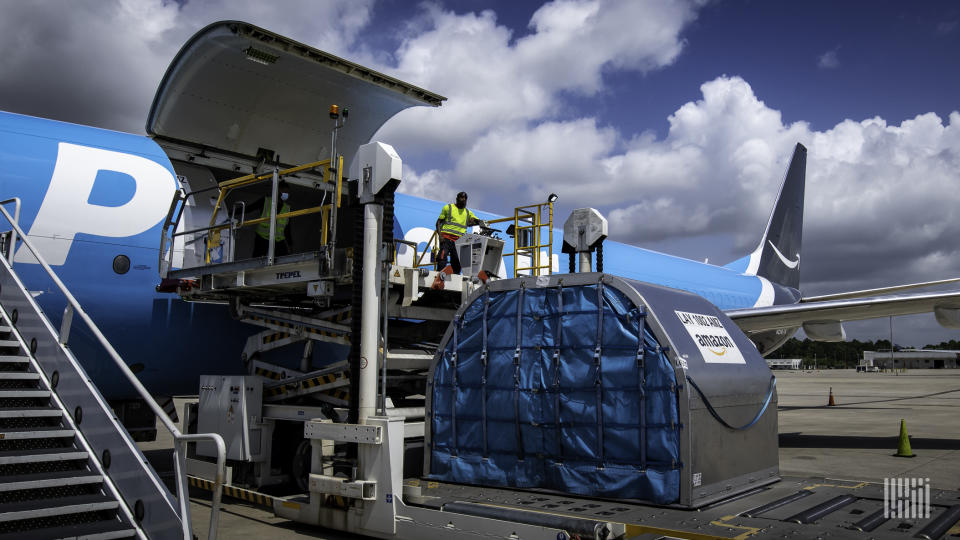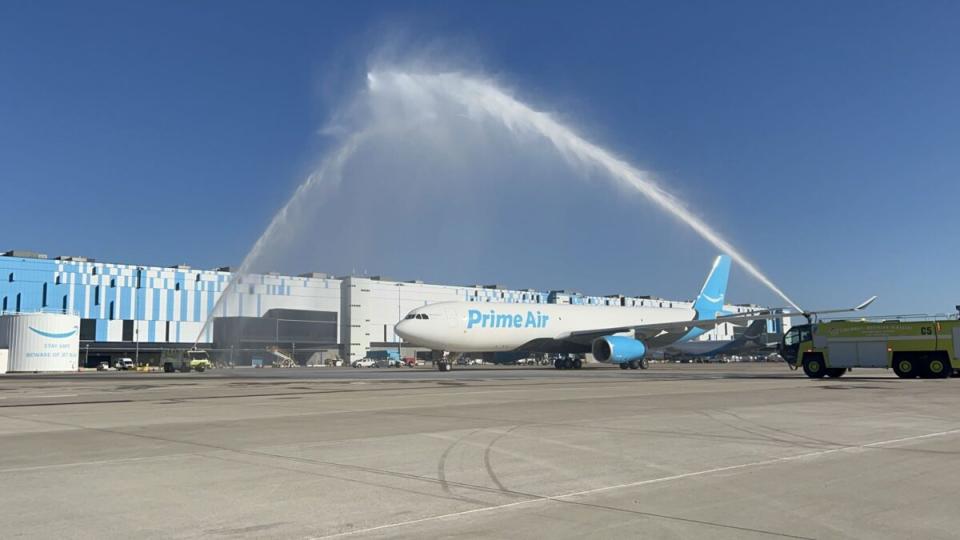Amazon concentrates parcel freighters at US air hubs, report says

Amazon’s private cargo airline, Amazon Air, took a different approach with its North American and European networks during the past 12 months. It has been streamlining operations in the U.S. by prioritizing larger planes and major hubs, but relying less on hubs in Europe as flight activity decreases, according to a report published Thursday.
The air logistics unit’s meteoric growth has ended after seven years, but the company was able to maintain operating levels at a time when many cargo airlines, including FedEx and UPS, parked aircraft and reduced flights in response to the downturn in air cargo demand.
Perhaps more noteworthy, Amazon Air (NASDAQ: AMZN) largely kept its fleet and flight schedule intact even as growth in e-commerce sales normalized and the mega-retailer shifted to a regional fulfillment model that decreases reliance on air transport.
The report from the Chaddick Institute for Metropolitan Development at DePaul University described how Amazon has 4.6% more payload capacity than a year ago despite having one fewer plane. It has also mostly transitioned to a hub-and-spoke model that mirrors FedEx and UPS, with less point-to-point flying. While total daily flights fell by 1.8%, to 202 per day, Amazon Air’s available ton-miles grew.
The researchers, led by Chaddick Institute Director Joseph Schwieterman, relied on geospatial mapping with flight tracking data for their analysis.
More than four in five Amazon Air flights within the U.S. mainland operate to or from its five largest hubs, up from 65.6% in early 2021. Flight activity at four of its five busiest hubs — Cincinnati-Northern Kentucky (CVG); San Bernardino, California; Ohio’s Wilmington Air Park; and Florida’s Lakeland-Linder — all grew over the past year.
Only Fort Worth Alliance Airport in Texas diminished in flight activity, a result researchers attributed to Amazon’s decision to discontinue use of five ATR-72 turboprop aircraft operated by Silver Airways and which accounted for a tiny fraction of the terminal’s tonnage.
Amazon relies on partner carriers, such as Silver, to operate its network because it isn’t a pure airline with its own operating authority. Amazon’s active fleet has plateaued in the past 18 months at about 80 aircraft, according to various aircraft databases. But during the peak of pandemic home shopping the fleet reached 88 aircraft.
Lakeland is now Amazon’s second-largest hub, with nearly 21 flights per day.
The Ohio Valley has become Amazon Air’s strategic center, accounting for more than half the flights in the U.S. mainland. After initially borrowing space from DHL Express, Amazon opened its own $1.5 billion facility at Cincinnati-Northern Kentucky airport. Flights at CVG increased from 57.5 to 63.3 per day in the past 12 months, not including about six flights by unmarked partner carriers, according to the report. Wilmington Air Park, only 60 miles away, handles 20 flights per day. Concentrating flights at the Cincinnati hub, and clustering them into two tight arrival and departure blocks, allows for efficient plane-to-plane transfers that support overnight delivery.
Amazon Air still lags FedEx and UPS in proficiency, with turnaround times for aircraft of about five hours versus two to three hours for the integrated logistics providers, the Chaddick report said. At 8 years old, Amazon Air is still maturing. FedEx and UPS have operated air transport networks with huge hubs for decades.
Ditching the small turboprops was one of several adjustments Amazon made to its freighter fleet to better align the network with consumer demand and the renewed emphasis on regional order fulfillment. E-commerce sales in 2023 increased 7.6% to $1.1 trillion — more than three times the rate of growth for total retail sales. Last year, online shopping accounted for 15.4% of total sales, according to the U.S. Census Bureau. After exploding 43% during the first year of the pandemic, annual e-commerce sales growth is expected to be less than 10% in the coming years.
Amazon returned five Boeing 767-200 freighters because the lease expired and they were old. (It is scheduled to give back an additional seven 767-200s next month, the lessor recently said.) Meanwhile, Amazon added three 767-300 planes, all operated by contractor Air Transport International, and its first Airbus A330-300, operated by Hawaiian Airlines. In the process, the percentage of the fleet consisting of Boeing 737 or smaller planes, has fallen from 38% to 33% over the past year.
Amazon has signed leases for nine more A330-300 converted freighters, which are larger than the 767 widebodies.
The Silver Airways freighters — and air service to Des Moines, Iowa; Omaha, Nebraska; and Wichita, Kansas — became expendable as Amazon moved to a fully regional, rather than national, fulfillment model. With orders distributed from eight regions, a good truck linehaul can perform as well as aircraft in key city pairs at lower cost with little to no impact for customers in small markets, logistics experts say.
In its effort to simplify the U.S. network, Amazon Air also ended regular flights to Mobile, Alabama; San Jose, California; and Tampa, Florida. Tampa is less than an hour’s drive from Lakeland-Linder airport. The company also halved air service to Las Vegas, which is less than four hours by truck from its San Bernardino hub, and cut service by about a third at Baltimore-Washington airport, which is a 7.5-hour drive from the Wilmington hub.
Last month, Amazon gave notice it is pulling out of San Antonio’s airport, closing on April 10. Amazon has air service to Austin, Texas, which is only an hour from San Antonio by truck. By April, Amazon will be in 47 U.S. airports, down from 53 last year.
In 2022, Amazon restructured fulfillment operations and transportation networks across the U.S., dividing them into smaller, easier-to-serve regions. That allowed the retailer to better utilize close-by inventory, while reducing stops per package and decreasing reliance on air transportation. Amazon says shortening the distance that deliveries have to travel to reach customers and improving inventory placement have helped achieve the fastest-ever shipping speeds.
Amazon always placed some inventory in regional warehouses to improve delivery times and reduce cost, according to a former Amazon executive who asked not to be named, but has now engineered its entire logistics network around that model. That means distribution centers have a limited mix of products available for same-day or next-day delivery. If a shopper, especially in a non-major metro area, wants a ruffled bed sheet instead of a standard one, he or she may have to wait more than two days for it to be shipped from a larger distribution center farther away.
Trucks do well for short and medium lengths of haul to less populated areas because customers have learned to accept that a special delivery may take longer, or that the order cutoff time may be earlier for day-definite delivery, the industry source said. In this scenario, freighters become more of a luxury used to enhance customer satisfaction with a speedy delivery from one regional center to another when there is a mismatch in regional inventory levels.

“I would argue that some of these 737s that they fly, say from Dallas to New Orleans, are not necessary because nothing you’re flying on short haul is profitable,” the individual said.
The report noted that Amazon is increasingly reluctant to deploy many flights at passenger-focused airports that are crowded and have limited room for warehouse expansion. Chicago-Rockford, Lehigh Valley airport in Pennsylvania and Sacramento airport in California have picked up flights while flights have diminished, or stayed flat, at Chicago O’Hare, New York John F. Kennedy and San Francisco airports.
A Chaddick Institute report last August found that cargo-focused airports outside large metropolitan areas give freighter operators several advantages, including faster shipment discharge and developable land for cargo facilities.
Changes to European network
While Amazon Air slightly increased U.S. capacity and added a handful of daily flights in Canada and India, flight activity in Europe dropped by more than a third over the past year. That followed a 29% reduction in flights in 2022. Reductions included flights carried out by partner airlines using their own unbranded aircraft. Amazon has about nine branded aircraft in its European fleet.
Late last year, Amazon closed its regional air hub at Leipzig/Halle International Airport in Germany in response to a downturn in e-commerce sales and parcel volumes. Activity peaked in early 2022 at 18 flights per day, operated by contractor ASL Airlines Ireland using Boeing 737-800 converted freighters. All but one route was shifted to Hannover in northern Germany and Liege airport in Belgium. Leipzig now averages fewer than two Amazon flights per day.
Amazon Air completely exited Germany’s Cologne/Bonn airport in late 2022 and has sharply cut back flights at two U.K. airports in the aftermath of Brexit.
The network currently serves 10 airports, down from a high of 13 three years ago. More than 80% of Europe’s population remains within 300 miles of an Amazon Air airport. Such distances can be covered within a day on a truck, the report says.
Outlook
Amazon’s domestic fleet outperformed normal seasonality in February with the flight count up 13% year over year after being flat in January, according to the Alpha Parcel Tracker report from Morgan Stanley.
The Chaddick researchers predicted that in the next year Amazon Air will gradually begin to expand flight operations, mostly at its CVG national hub and four large regional hubs. By mid-2025, the combined daily flight activity at CVG and Wilmington will grow to more than 125, including partner flights, with CVG alone having at least 85. Nonhub flying will be simultaneously reduced.
Amazon will remain relatively small in Europe, but it will grow again in a measured way, especially near where logistics infrastructure is being built, the report said. Potential growth areas include Scandinavia, Greece and the Balkan countries.
Click here for more FreightWaves/American Shipper articles by Eric Kulisch.
Contact Reporter: ekulisch@freightwaves.com
RECOMMENDED READING:
Pilots flying Amazon cargo say employer stalling contract talks
Amazon’s largest cargo jet makes debut
Amazon’s return of leased cargo jets hurts ATSG profit
The post Amazon concentrates parcel freighters at US air hubs, report says appeared first on FreightWaves.
